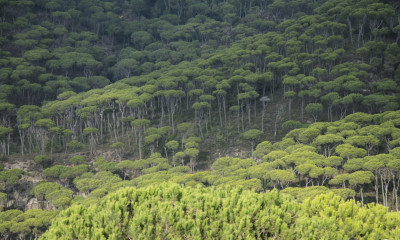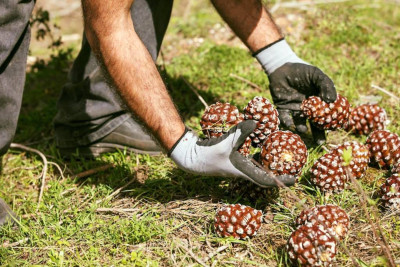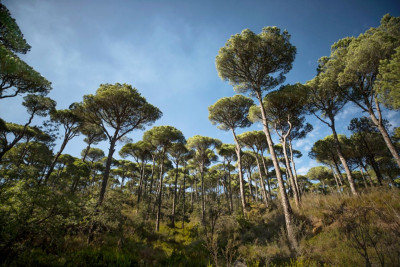Culture and harvest of pine trees
 The pine tree, according to the custom of the Lebanese, is known as “wealth of beauty and money.” It is what it secures from agricultural production. It is considered a factor of attraction for tourists, vacationers, and tourism investments. No one expected that the few plantings that Prince Fakhr al-Din II of Tuscany, Italy, carried in 1516 AD would cover about twenty threes percent of Lebanon’s green area, and the pine tree kept the citizens safe from economic crises such as the one that Lebanon witnessed from the mid-eighties of the last century. Several regions in Lebanon produce pine, but the Mount Lebanon region remains in the first place, as it has 80 percent of the total production.The forests best known for their pine production are those of Bkassine, Ras el metn and Salima where the pine trees constitute a wealth for the people of the region, which is distinguished by not needing permanent care. All that is required is that it be pruned once every four years.
The pine tree, according to the custom of the Lebanese, is known as “wealth of beauty and money.” It is what it secures from agricultural production. It is considered a factor of attraction for tourists, vacationers, and tourism investments. No one expected that the few plantings that Prince Fakhr al-Din II of Tuscany, Italy, carried in 1516 AD would cover about twenty threes percent of Lebanon’s green area, and the pine tree kept the citizens safe from economic crises such as the one that Lebanon witnessed from the mid-eighties of the last century. Several regions in Lebanon produce pine, but the Mount Lebanon region remains in the first place, as it has 80 percent of the total production.The forests best known for their pine production are those of Bkassine, Ras el metn and Salima where the pine trees constitute a wealth for the people of the region, which is distinguished by not needing permanent care. All that is required is that it be pruned once every four years.
 Pine cone harvest and drying season begins in June. The first stage of harvesting is the most difficult and dangerous. It begins with dropping the cones from the branches of trees that reach a height of more than ten meters. one or two men climb on the tree and pick the cones with a reed or an iron rod called “me’aili” (hanger) on the ground. While men and women collect the cones and spread them on the roads or on the roofs of the houses exposing them to the sun until they dry. In the last stage, the pine nuts are separate from the cones through modern machines. After cleaning the kernels, a special machine works to break them and extract the pine nuts.
Pine cone harvest and drying season begins in June. The first stage of harvesting is the most difficult and dangerous. It begins with dropping the cones from the branches of trees that reach a height of more than ten meters. one or two men climb on the tree and pick the cones with a reed or an iron rod called “me’aili” (hanger) on the ground. While men and women collect the cones and spread them on the roads or on the roofs of the houses exposing them to the sun until they dry. In the last stage, the pine nuts are separate from the cones through modern machines. After cleaning the kernels, a special machine works to break them and extract the pine nuts.
 Lebanese pine nuts are used in the preparation of varieties of special food dishes, appetizers and desserts. They have a special feature in terms of their high quality and distinctive flavor, which is not found in other countries. It is the reason why they are called “white gold”. In addition, their oil can be used in the pharmaceutical industry, the extract of pine bark is used for alkaline lands to increase their acidity, while the wood of the pruned tree is used for heating or in the manufacture of furniture, and its dust can be used as fertilizer for the soil.
Lebanese pine nuts are used in the preparation of varieties of special food dishes, appetizers and desserts. They have a special feature in terms of their high quality and distinctive flavor, which is not found in other countries. It is the reason why they are called “white gold”. In addition, their oil can be used in the pharmaceutical industry, the extract of pine bark is used for alkaline lands to increase their acidity, while the wood of the pruned tree is used for heating or in the manufacture of furniture, and its dust can be used as fertilizer for the soil.
The pine trees, providing a significant income to rural families are threatened with extinction. Bsides, the urbanization making them disappear, they are affected by several diseases that dry them out and decimate them.

